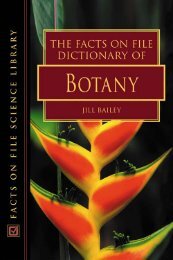You also want an ePaper? Increase the reach of your titles
YUMPU automatically turns print PDFs into web optimized ePapers that Google loves.
7.26 7.26 Fine rOOfS from a large tree of the<br />
dicotyledon Fraxlnus excelsior (ash)<br />
growing in the cracks of a rock face. These<br />
toon have grown down from the main<br />
branch roors in ,he soil above and their<br />
expansion by secondary Ihickening growth,<br />
helps 10 further break open the exposed<br />
rock face.<br />
7.27 7.27 TS of the fleshy root of the<br />
dicotyledon Daucus ,;arota (carrot). The<br />
narrow core of primary xylem (1) is surrounded<br />
by an extensive hut mainly parenchymatous<br />
secondary Jlylem (2) in which a<br />
few tracheaey elements OCCUt. The welldefined<br />
vascular cambium (3) also produces<br />
centrifugally a largely parenchymatous<br />
secondary phloem (4). Cortex (5). (LM x<br />
30.)<br />
7.28<br />
144<br />
I Primary xylem.<br />
2 Secondary xylem<br />
3 Vascular cambium<br />
4 Secondary phloem<br />
5 Conex<br />
7.28 TS showing detail of the fleshy root<br />
of the dicotyledon Bela vulgaris (beetroot).<br />
The vascular cambium produces eJltensive<br />
patenchyma in the secondary xylem;<br />
supernumery cambia (1) arise within this<br />
tissue giving rise to discrete sttands of<br />
xylem (2) and phloem (3). (L:\1 x 30.)<br />
1 Supcrnumery cambia<br />
2 Xylem strands<br />
3 Phloem strands





